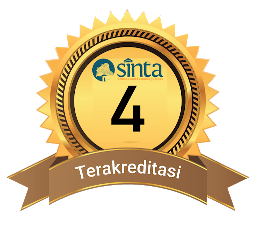Perbandingan Kadar Metabolit Sekunder Ekstrak Daun Sirih Cina (Peperomia Pellucida L. Kunth) Berdasarkan Faktor Intesitas Cahaya untuk Mendukung Perkuliahan Kimia Bahan Alam
DOI:
10.29303/cep.v8i1.6743Published:
2025-05-31Issue:
Vol. 8 No. 1 (2025): Edisi MeiKeywords:
Secondary Metabolites, Natural Material Chemastry, Light Intensity, Poster MediaArticles
Downloads
How to Cite
Abstract
This study aims to determine differences in levels of secondary metabolites of Chinese betel leaf extract which are affected by differences in light intensity and to determine the development of media posters as a means of supporting lectures on natural product chemistry. This research uses qualitative and quantitative methods of experiment and development. Based on the research results, Chinese betel leaf extract in sample 1 produced three secondary metabolites as well as sample 2. However, only two compounds could be compared between the two samples and these compounds were 3a(1H)-Azulenol, 2,3,4, 5,8,8a-hexahydro-6 and Dillapiole, while the compounds that cannot be compared are Cholest-5-en-3-ol(3 beta)-(CAS)lanol and Phenol,2,4-bis(1,1 -dimethylethyl)-(CAS) 2,4-Di-tert-butylphenol. The resulting level of the compound 3a(1H)-Azulenol,2,3,4,5,8,8a-hexahydro-6 (terpenoid) in sample 1 was 11.49% while in sample 2 it was 24.36%, and for the compound dillapiole (phenylpropanoid) content produced in sample 1 was 14.26% while in sample 2 it was 36.47%. For the compound cholest-5-en-3-ol (steroid) it produced a concentration of 74.25% in sample 1 while in sample 2 it was compound not detected and for the compound Phenol,2,4-bis(1,1-dimethylethyl)-(CAS ) 2,4-Di-tert-butylphenol (flavonoid) in sample 2 produced a level of 5.78% while in sample 1 it was compound not detected. Based on this, there were differences in the levels of secondary metabolites which were affected by light intensity. In developing poster media, stating that poster media is very feasible and practical to display so that poster media is not revised, this is based on the results of validity tests and trials.
References
Andriani, Lili., Thatha Monica & Noer Intan Lubis. (2022). “Pemanfaatan Tanaman Herbal (Sirih Cina, Jahe, dan Kayu Manis) Melalui Kegiatan KKN di RT 03 Kelurahan Suka Karya Kecamatan Kotabaru, Kota Jambi”. Jurnal Abdi Masyarakat Indonesia. 2(2): 465-472.
Angelina, Marissa., Puteri Amelia., Muchammad Irsyad., Lia Meilawati & Muhammad Hanafi. (2015). “Karakterisasi Ekstrak Etanol Herba Ketumpang Air (Peperomia pellucida L. Kunth)”. Biopropal Industri. 6(2): 53-61.
Anggraeni, E. V., & Anam, K. (2016). Identifikasi Kandungan kimia dan uji aktivitas antimikroba kulit durian (Durio zibethinus Murr.). Jurnal Kimia Sains dan Aplikasi, 19(3), 87-93.
Dewijanti, Indah Dwiatmi., Marissa Angelina., Sri Hartati., Betty Ernawati Dewi & Lia Meilawati. (2017). “Nilai LD50 dan LC50 Ekstrak Etanol Herba Ketumpangan Air (Peperomia Pellucida (L.) Kunth)”. Jurnal Ilmu Kefarmasian Indonesia. 12(2): 255-260.
Ekawati, M. A., Suirta, I. W., & Santi, S. R. (2017). Isolasi dan identifikasi senyawa flavonoid pada daun sembukan (Paederia foetida L) serta uji aktivitasnya sebagai antioksidan. Jurnal Kimia, 11(1), 43-48.
Imansyah, Maulana Zulkarnain & Sri Handayani. (2022). “Uji Aktivitas Ekstrak Etanol Daun Sirih Cina (Peperomia Pellucida L.) Terhadap Bakteri Propionibacterium Acnes”. Jurnal Kesehatan Yamasi Makassar. 6(1): 40-47.
Indriyani, Lusia. 2018. Pengembangan Media Poster Sebagai Bahan Ajar dalam Perkembangan Kognitif Anak Usia Dini. Lampung: Universitas Islam Negeri Raden Intan.
Permadani, A., Nikmah, H., Halimatussakdiah, H., Mastura, M., & Amna, U. (2024). Skrining Fitokimia Daun Sirih Cina (Peperomia pellucida L.) dari Kecamatan Bireun Bayeun, Aceh Timur. QUIMICA: Jurnal Kimia Sains dan Terapan, 6(1), 6-12. DOI: https://doi.org/10.33059/jq.v6i1.10259
Putri, A. Y. (2021). Uji Aktivitas Dan Efektivitas Antibakteri Ekstrak Dan Fraksinasi Herba Sirih Cina (Peperomia pellucida L. Kunth) Terhadap Staphylococcus aureus (Doctoral dissertation, Sekolah Tinggi Ilmu Kesehatan Borneo Cendekia Medika Pangkalan Bun).
Rachmasari, O. D., Prihanta, W., & Susetyarini, R. E. (2016). Keanekaragaman serangga permukaan tanah di Arboretum Sumber Brantas Batu-Malang sebagai dasar pembuatan sumber belajar flipchart. Jurnal Pendidikan Biologi Indonesia, 2(2), 188-197.
Riduwan. 2012. Belajar Mudah Penelitian untuk Guru-Karyawan dan Peneliti Pemula. Alfabeta.
Sholekah, Friska Fitriani. (2017). “Perbedaan Ketinggian Tempat Terhadap Kandungan Flavonoid dan Beta Karoten Buah Karika (Carica Pubescens) Daerah Dieng Wonosobo”. In Prosiding Seminar Nasional Pendidikan Biologi dan Biologi (pp. 75-82).
Sitorus, Erwin., Lidya Irma Momuat & Dewa Gede Katja. (2013). “Aktivitas Antioksidan Tumbuhan Suruhan (Peperomia Pellucida L. Kunth)”. Jurnal Ilmiah Sains. 13(1): 80-85.
Sudjarwo, G. W., Mahmiah, M., & Andriyani, F. (2017). SKRINING FITOKIMIA DAN ANALISIS GC-MS HASIL FRAKSI HEKSANA KULIT BATANG RHIZOPHORA MUCRONATA L. Seminar Nasional Kelautan XII.
Utomo, D. S., Kristiani, E. B. E., & Mahardika, A. (2020). Pengaruh Lokasi Tumbuh Terhadap Kadar Flavonoid, Fenolik, Klorofil, Karotenoid Dan Aktivitas Antioksidan Pada Tumbuhan Pecut Kuda (Stachytarpheta Jamaicensis). Bioma: Berkala Ilmiah Biologi, 22(2), 143-149
Yuliani, Dinia., Intan Keumala Dewi & Siti Marhamah. (2022). “Efektivitas Ekstrak Daun Sirih Cina (Peperomia Pellucida) Terhadap Pertumbuhan Bakteri Propionibacterium Acnes dan Tinjauannya Menurut Pandangan Islam”. Jurnal Sosial Sains. 2(1):173-181.
Author Biography
Rahmawati Rahmawati, Pendidikan Kimia, Universitas Mataram
License
Copyright (c) 2025 Aprilia Maharani; Aliefman Hakim; Rahmawati

This work is licensed under a Creative Commons Attribution-ShareAlike 4.0 International License.
Authors who publish with Chemistry Education Practice agree to the following terms:
- Authors retain copyright and grant the journal right of first publication with the work simultaneously licensed under a Creative Commons Attribution License 4.0 International License (CC-BY-SA License). This license allows authors to use all articles, data sets, graphics, and appendices in data mining applications, search engines, web sites, blogs, and other platforms by providing an appropriate reference. The journal allows the author(s) to hold the copyright without restrictions and will retain publishing rights without restrictions.
- Authors are able to enter into separate, additional contractual arrangements for the non-exclusive distribution of the journal's published version of the work (e.g., post it to an institutional repository or publish it in a book), with an acknowledgement of its initial publication in Chemistry Education Practice.
- Authors are permitted and encouraged to post their work online (e.g., in institutional repositories or on their website) prior to and during the submission process, as it can lead to productive exchanges, as well as earlier and greater citation of published work (See The Effect of Open Access).






